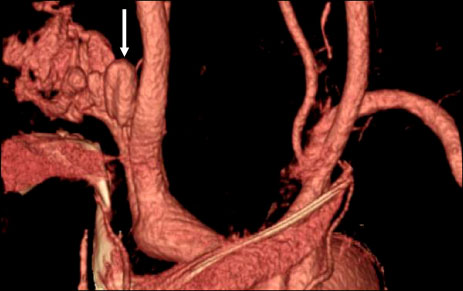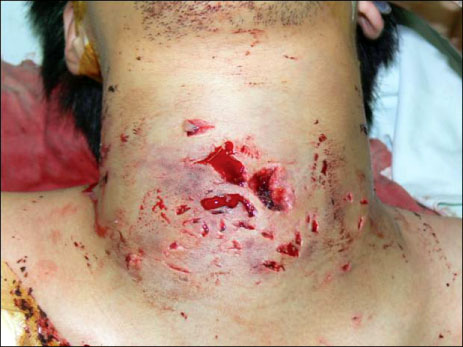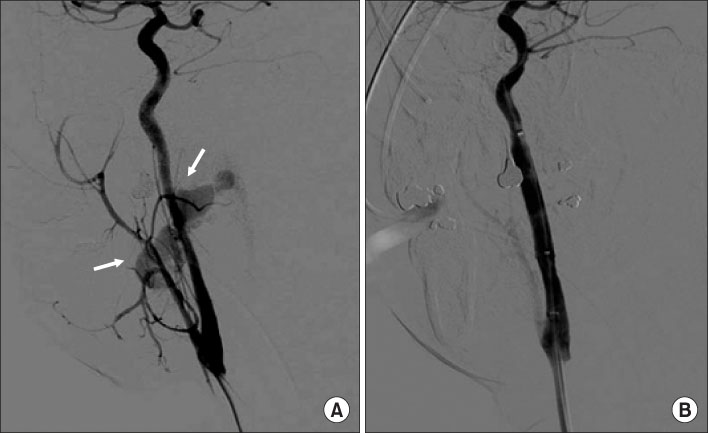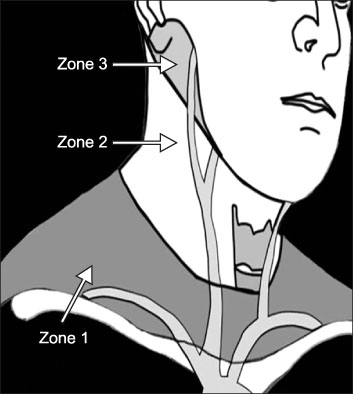Chonnam Med J.
2011 Aug;47(2):134-137. 10.4068/cmj.2011.47.2.134.
Penetrating Carotid Artery Injuries Treated by an Urgent Endovascular Stent Technique: Report of Two Cases
- Affiliations
-
- 1Department of Otolaryngology-Head and Neck Surgery, Gyeongsang National University, Jinju, Korea. lesaby@hanmail.net
- 2Institute of Health Sciences, School of Medicine, Gyeongsang National University, Jinju, Korea.
- KMID: 2048800
- DOI: http://doi.org/10.4068/cmj.2011.47.2.134
Abstract
- Penetrating neck injuries are potentially dangerous and require emergent management because of the presence of vital structures in the neck. Penetrating vascular trauma to zone I and III of the neck is potentially life-threatening. An accurate diagnosis and adequate surgical intervention are critical to the successful outcome of penetrating trauma in the neck. We experienced some cases with externally penetrating injuries in neck zone II in which the patients were confirmed to have the presence of large vessel injuries in neck zones I and III. Here we report on the endovascular stent techniques used in two cases to address penetrating carotid artery injuries and review the literature.
MeSH Terms
Figure
Reference
-
1. Kim JP, Kim JW, Ahn SK, Jeon SY. A case of the zone III neck injury by impalement of a metal stick. Korean J Otolaryngol-Head Neck Surg. 2003. 46:610–612.2. Perry MO, Snyder WH, Thal ER. Carotid artery injuries caused by blunt trauma. Ann Surg. 1980. 192:74–77.
Article3. Roon AJ, Christensen N. Evaluation and treatment of penetrating cervical injuries. J Trauma. 1979. 19:391–397.
Article4. Siegrist B, Steeb G. Penetrating neck injuries. South Med J. 2000. 93:567–570.
Article5. Watson JM, Goldstein LJ. Golf club shaft impalement: case report of a zone III neck injury. J Trauma. 1996. 41:1036–1038.6. Demetriades D, Theodorou D, Cornwell E, Berne TV, Asensio J, Belzberg H, et al. Evaluation of penetrating injuries of the neck: prospective study of 223 patients. World J Surg. 1997. 21:41–47.
Article7. Bell RB, Osborn T, Dierks EJ, Potter BE, Long WB. Management of penetrating neck injuries: a new paradigm for civilian trauma. J Oral Maxillofac Surg. 2007. 65:691–705.
Article8. Múnera F, Soto JA, Nunez D. Penetrating injuries of the neck and the increasing role of CTA. Emerg Radiol. 2004. 10:303–309.9. Múnera F, Soto JA, Palacio DM, Castañeda J, Morales C, Sanabria A, et al. Penetrating neck injuries: helical CT angiography for initial evaluation. Radiology. 2002. 224:366–372.
Article10. Feugier P, Vulliez A, Bina N, Floccard B, Allaouchiche B. Urgent endovascular covered-stent treatment of internal carotid artery injury caused by a gunshot. Eur J Vasc Endovasc Surg. 2007. 34:663–665.
Article
- Full Text Links
- Actions
-
Cited
- CITED
-
- Close
- Share
- Similar articles
-
- A Case of the Zone III Penetrating Neck Injury with Internal Carotid Artery Laceration Treated by an Urgent Endovascular Stent Technique
- Stent Graft Repair of Penetrated Injury of the Common Carotid Artery
- Conjoined Stent Technique for Radiation Induced Long Segment Carotid Stenosis and Pseudoaneurysm
- Endovascular Stent Treatment for Traumatic Common Carotid Artery Dissection with Cerebral Infarction : Case Report and Literature Review
- Treatment of Internal Carotid Artery Dissections with Endovascular Stent Placement: Report of Two Cases






